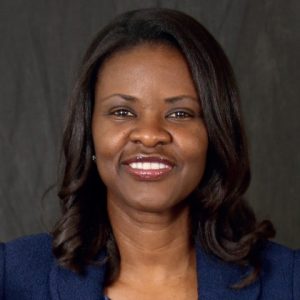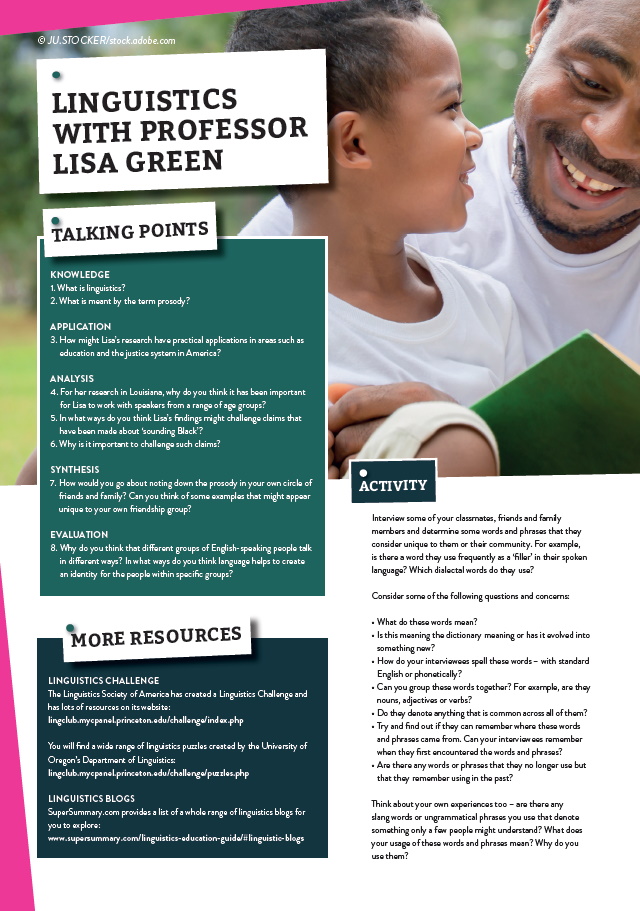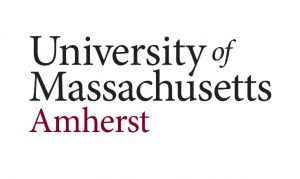Variation and grammar in African American English
Professor Lisa Green, based at the University of Massachusetts Amherst in the US, leads research investigating the variation and grammar of African American English in children and adults. Her findings will include insights into the properties of children’s early language use and the stages of development involved
TALK LIKE A LINGUIST
AFRICAN AMERICAN ENGLISH (AAE), ALSO KNOWN AS AFRICAN AMERICAN LANGUAGE – a linguistic variety which may be used by speakers who have contact or close association with networks of communities of African Americans
DIALECT – a particular form of a language which is peculiar to a specific region or social group
GRAMMAR – the branch of linguistics looking at syntax and word forms
LANGUAGE ACQUISITION – the process by which humans acquire the capacity to perceive and comprehend language
LANGUAGE DISORDER – a significant impairment in the acquisition and use of language
LEXICAL PATTERN – words that occur in language with high frequency
PERFECT TENSE – a verb form (used with a form of ‘to have’) to show something has been or will be completed. For example, I have walked, I had walked and I will have walked
PHONETICS – the study of classification of speech sounds
PHONOLOGY – the study of speech sounds of a language or languages
PROSODY – the rhythm, stress and intonation of speech
SEMANTICS – the branch of linguistics and logic concerned with meaning
SYNTAX – the study of how words combine to form larger units such as phrases and sentences
TENSE – the form of a verb used to indicate time of action (in terms of when it is uttered, for example, past, present, in the future or continuing)
For most of us, acquiring language seems to have happened automatically – so easily, in fact, that it is hard for us to comprehend a time when we did not speak and communicate as we do now. Of course, along the path of learning language, many of us will have faced challenges – be it how to pronounce words, finding the confidence to put words together into a coherent sentence or even learning a completely new language – but it can seem as if our linguistic abilities have always been with us.
For researchers in the field of linguistics, the ways in which we acquire properties of language, including dialects of languages, and how we use them, is of huge interest – it is a complex field that poses more questions than our supposedly innate ability to acquire language might first suggest. Consider the English language, for example. In 2021, there were approximately 1.4 billion English speakers in the world, and the range of those speakers meant that there were many variations of the English language around the globe. How do these forms of English vary? How do speakers of these variations acquire their language? What are the implications of this for education and other social contexts? In what ways are different forms of English perceived? Professor Lisa Green is a researcher at the University of Massachusetts Amherst who is exploring the intricacies of language. Currently, she is involved with research projects on variation and grammatical patterns in child and adult African American English (AAE).
WHAT RESEARCH METHODS ARE USED WHEN EXAMINING DIALECT ACQUISITION?
In conducting the child AAE research, Lisa interacts with children (aged three to six years old) who describe toys and objects as they explore and play with them in different make-believe contexts, which enables her to collect examples of spontaneous speech. She also collects data in experimental settings, where she uses structured prompts to elicit children’s responses. Lisa then uses linguistic description and general principles of linguistic theory to analyse the data. In addition, quantitative analysis of certain constructions and verb endings, such as -ed or -s, can be useful in understanding how children use certain forms of language along their developmental paths.
WHAT COLLABORATIONS HAS THE RESEARCH BENEFITED FROM?
Some of the projects associated with this research are collaborative efforts with Brandi Newkirk-Turner, who is the Professor of Communicative Disorders and Associate Provost of Academic Affairs at Jackson State University in the US. This collaboration on the EAGER project brought together data from the states of Mississippi and Louisiana. “Given Dr Newkirk-Turner’s expertise in the field of communicative disorders, through this research, we have been able to address questions raised in both fields – linguistics and communicative disorders,” explains Lisa. “In addition, in bringing the two areas together, we have been able to make some advances in discussions about how our research can be extended to practical applications. For instance, in one publication, we explained how speech pathologists could extend what we found in our research to assessment.”
WHAT QUESTIONS IS LISA ATTEMPTING TO ANSWER?
As a linguist, Lisa is concerned with typical language development, so some of the questions that her research is attempting to answer are: ‘What does typical development of variation in AAE-speaking communities look like?’, ‘What is the overlap between typical development of variation and variation in AAE?’ and ‘What are these degrees of variation?’
In her collaborative project concerned with sentence structure, meaning and prosody, Lisa, along with UMASS Amherst colleagues in linguistics, computer science, and Spanish and Portuguese, is aiming to develop linguistic analytical tools to better understand prosody in AAL. Despite a lack of research, claims have been made that ethnic identification of African
Americans is possible based on small amounts of speech. In addition, there have been several claims about ‘sounding Black’ and features of AAE prosody. “Some general properties, such as wider pitch range, have been identified in AAE. However, very little prosodic research has been conducted on the linguistic variety,” says Lisa. “In addition to determining patterns of intonation in AAE, further research could provide information about the extent to which current conventions for annotating contours in general American English can be used for AAE.”
Reference
https://doi.org/10.33424/FUTURUM299
© JenkoAtaman/stock.adobe.com
© Supachai/stock.adobe.com
© Seventyfour/stock.adobe.com
© kanpisut/stock.adobe.com
WHAT HAS THE PROSODIC FIELDWORK LOOKED LIKE IN PRACTICE?
Lisa began conducting research in a small community in southwest Louisiana more than 25 years ago and has continued to work with speakers of all ages in that community ever since. One of the areas of focus for this fieldwork has been BIN, a remote past marker in AAE. “BIN has been described as a stressed element, so elicitation tasks were used – tasks that were designed to elicit the past participle ‘been’, which is used in perfect tense contexts and to elicit BIN in different contexts,” explains Lisa. “Participants listened to recorded scenarios and responded with a sentence that contained either BIN or been. Although the spelling of the target form was always b-e-e-n in the tasks, participants pronounced the form with the remote past pronunciation (BIN), in which case the marker bears prominence, or with the ‘regular’ participle pronunciation, depending on their interpretation of the meaning conveyed by the scenario.”
WHAT IS THE REAL-WORLD IMPACT OF THIS RESEARCH?
Given that intonation in AAE, in general, and prosodic marking of BIN, in particular, are widely discussed but significantly understudied, Lisa’s research will contribute linguistic descriptions of parts of AAE prosody in current frameworks, which can be used in comparative studies of varieties of American English. Importantly, this research will have practical application in areas such as education and the justice system, where questions about ethnic identification, discrimination and social justice in relation to ‘sounding’ a certain way are relevant.
WHAT ARE THE NEXT STEPS?
Lisa intends to continue her work on developmental AAE among children, and she also intends to work on the structure of AAE and continue to collaborate with researchers at the University of Massachusetts Amherst in investigating variation in AAE in different regions of the US. “I want to analyse regional variation in AAE and explore the concept of AAE on a continuum in which speakers of different backgrounds and members of different types of social networks produce AAE in varying degrees,” says Lisa. “Then, there is my book project, which explores research on AAE over the past 50 years.”
 PROFESSOR LISA GREEN
PROFESSOR LISA GREEN
Department of Linguistics, The University of Massachusetts Amherst, USA
FIELD OF RESEARCH: Linguistics
RESEARCH: Investigating the variation and grammar of African American English
FUNDER: US National Science Foundation (NSF)
EAGER: Collaborative Research: Variation and the Grammar of Child African American English
Grant #1744503
(co-PI: Professor Brandi Newkirk-Turner)
Understanding Variation in African American Language: Corpus and Prosodic Fieldwork Perspectives
Grant #2042939
(co-PIs: Kristine Yu, Lisa Green, Brendan O’Connor, Meghan Armstong-Abrami)
ABOUT LINGUISTICS
Linguistics is the scientific study of language and involves analysing various aspects, such as form, structure and context. As with Lisa’s research, linguistics can also investigate the relationship between sound, sentence structure and meaning, and how language varies between people, demographics and situations.
WHAT MOTIVATES LISA TO WORK IN THIS FIELD?
Lisa’s research helps her to learn more about the structure of African American English. “Over the years, less attention has been paid to AAE as a linguistic system that is used in social contexts and as a marker of identity,” explains Lisa. “I am motivated by the many unanswered questions about different components of the grammar of AAE. Also, results from this research have potential for practical application in areas such as education, speech pathology and social realms.”
WHAT CAREERS ADVICE CAN LISA OFFER?
In considering linguistics, it is important for students to understand whether they are more interested in the type of training one receives in linguistics programmes that would strengthen their transferable skills or whether they are focused on linguistics because they want specific careers in the field (e.g., computational linguistics, linguistics in higher education or academia). “If you are interested in the training you would receive in undergraduate programmes in linguistics, you should understand what types of skills you would acquire and what types of occupations those skills would match,” says Lisa. “If you want a career in fields in linguistics, you should be prepared for graduate training, especially for academia-related careers.”
IN WHICH AREAS WILL THE NEXT GENERATION OF LINGUISTS FOCUS THEIR RESEARCH ATTENTIONS?
Some future linguists will focus on computational linguistics, a growing field which continues to expand in directions such as computational sociolinguistics, especially given the focus of social media and large corporations. There is already considerable interest in the use of AAE on social media and its influence, so it is likely that research on AAE will be conducted in different areas of computational linguistics.
EXPLORE CAREERS IN LINGUISTICS
• The Linguistic Society of America is a brilliant resource for those interested in pursuing a career in linguistics.
• SuperSummary has a comprehensive linguistics education resource guide that contains information regarding psycholinguistics and sociolinguistics, as well as other disciplines.
• Prospects has some useful information about what careers a linguistics degree can lead to.
• Linguistics can also lead to careers in various industries. Read this interesting article about careers for linguists in the tech industry.
• According to payscale.com, the average salary for a linguist in the US is approximately $77,000, depending on experience.
PATHWAY FROM SCHOOL TO LINGUISTICS
Lisa explains, “Humanities subjects in high school might lead to interest in linguistics, but the way that linguists look at language is different from how most students will look at language while at school – which is what makes it so fascinating! Linguistics-related university courses may be offered in different departments (including philosophy, psychology and computer science).”
The website, The Student, suggests that school and college subjects such as English language, communication studies, a foreign language, psychology, sociology and philosophy could introduce you to elements of linguistics. It also has a useful guide explaining what you can expect to learn on a linguistics course.
The Complete University Guide provides some interesting information about studying linguistics at university level.
Find out more about studying linguistics at Lisa’s university.
See the Center for the Study of African American Language for summer research experiences on topics related to the study of AAE.
Some linguistics graduates go on to study at master’s level to specialise in an area of linguistics of particular interest to them, such as applied linguistics, forensic linguistics and language sciences.
HOW DID LISA BECOME A LINGUIST?
WHAT WERE YOUR INTERESTS WHEN YOU WERE GROWING UP?
I was always interested in reading books and writing, and putting the two together. I started writing a book when I was in 8th grade. I was also interested in areas of nursing and psychiatry based on what I had seen on television.
WHO OR WHAT INSPIRED YOU TO BECOME A LINGUIST?
My interest in linguistics was sparked by a visiting professor at my undergraduate institution and by a professor in my MA programme. My fascination with language in the works of Zora Neale Hurston led me to raise questions about how the study of dialects related to research in linguistics.
WHAT DO YOU ENJOY ABOUT LINGUISTIC RESEARCH AND TEACHING?
There are two reasons I am passionate about research in linguistics. First, it gives me insight into how languages vary, especially non-standard dialects, which are not always discussed in general linguistics. Also, some of the angles of my research have the potential to impact more practical areas such as education and speech pathology. Teaching gives me the opportunity to share information with students who have little or no interaction with understudied language communities, and it forces me to think about my research and find effective ways to convey it to students.
WHAT ARE YOUR PROUDEST MOMENTS, SO FAR?
In fall 2021, I taught an upper division undergraduate course on language in social contexts. Some of the cutting-edge research on these topics is being conducted by linguists whom I either taught or worked with on their dissertation research. I invited a few of these linguists to talk to my class about their projects; it was a great experience to see how much these young researchers have achieved and what excellent contributions they are making.
WHAT ARE YOUR AMBITIONS FOR THE FUTURE?
My goal is to continue to contribute to research on AAE and, as Director of the Center for the Study of African American Language, to continue to work on projects that foster and integrate basic research on language in the African American communities and applications of that research in educational, social and cultural realms. Some of these projects involve summer programmes, during which college students from Historically Black Colleges and Universities (HBCUs), as well as predominantly white institutions in the US, gain research experiences as they learn about the structure of AAE through working on data. Some of the participants have enrolled in graduate programmes in linguistics and linguistics-related disciplines and gone on to become published college professors.
LISA’S TOP TIP
People should have a clear understanding of what linguistics is, the career opportunities that might be available and the type of preparation necessary for those careers. Take the opportunity to read about linguistics and the types of projects linguists develop.
Do you have a question for Lisa?
Write it in the comments box below and Lisa will get back to you. (Remember, researchers are very busy people, so you may have to wait a few days.)










